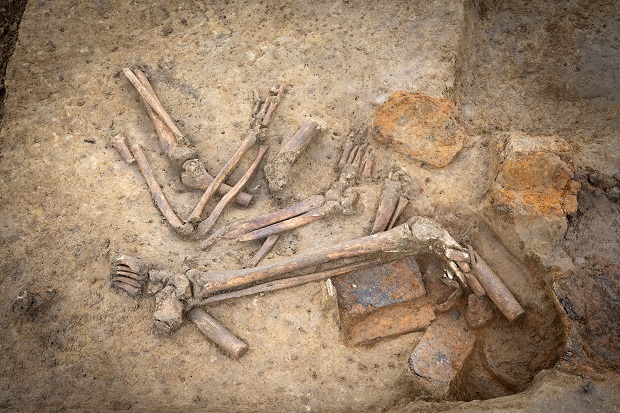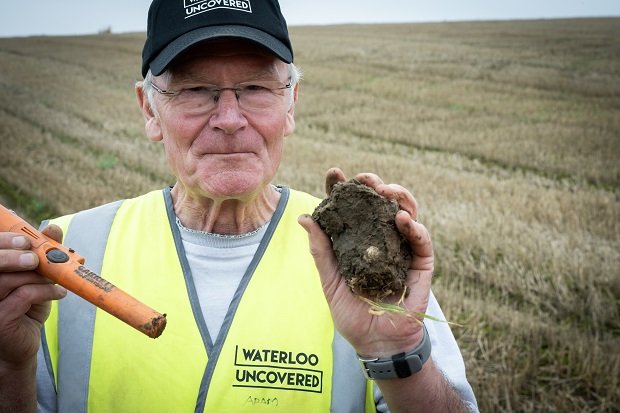- Daily & Weekly newsletters
- Buy & download The Bulletin
- Comment on our articles
New Waterloo dig reveals ‘unique’ battle gore trench of shot horses and amputated limbs
Archaeologists and military veterans have unearthed a unique clearance trench on the site of a former field hospital at Mont-Saint-Jean farm near Waterloo.
The discoveries by Waterloo Uncovered, an international team of veterans, serving personnel and archaeologists, offer further insights into the horror of the aftermath of the 1815 clash.
As Belgium was then part of the French Empire, the rural town of Waterloo was a strategic location for an army of European allies determined to prevent Napoleon reaching the capital. If the French commander met his Waterloo in the two-day battle and 23 years of conflict in Europe was brought to an end, it claimed the lives of at least 20,000 soldiers.
The rolling hills around Mont-Saint-Jean have since become a memorial site and an international tourist destination. They have also attracted military historians and archaeologists, whose findings provide a compelling picture of the harrowing reality of the conflict.

Halfway though a new two-week dig at the farm’s orchard that was once Wellington’s field hospital, archaeologists have confirmed that a purpose-built pit was probably designed to quickly clear the hospital of “gore” after the battle.

Deposits of human and animal remains were found separated by a barrier of ammunition boxes (pictured above) stripped from soldier’s leather satchels. The team says it uncovered the skeletons of an ox and at least seven horses, several of which showed signs of being butchered, while three had been euthanised via a musket ball to the head.

More than 500 amputated limbs “piling up in all four corners of the courtyard” were buried (pictured above) alongside the remains of a lone soldier uncovered by the charity two years ago.
“I can’t think of any other site that has this combination of elements – it’s truly unique, within Napoleonic archaeology and beyond,” says Tony Pollard (pictured below), a professor at the University of Glasgow and one of the project's archaeological directors.

“The layout of the trench, with all animal remains on one side of the ammunition box barrier and all the human remains on the other, strongly suggests that the men who buried this individual attempted to offer him a level of dignity and respect despite the horrific scene they would have found themselves facing while clearing the field hospital of the dead.”
Pioneering project rehabilitating military veterans
The archaeologists have been working closely with veterans and serving personnel from the pioneering Waterloo Uncovered programme. It offers them a life-changing opportunity to take part in cutting-edge battlefield excavations while receiving dedicated wellbeing support.

John Dawson (pictured above), 35, was shot in the head while serving with the Grenadier Guards in Helmand Province in Afghanistan, losing his right eye and the use of his left arm. After undergoing significant surgery to reconstruct the right side of his head and fighting to regain the ability to walk, Dawson has been slowly rebuilding his independence and confidence.
“This is the first trip I’ve done without a support worker. Normally, I’d refuse to do things like this, but when my regiment contacted me about it, I decided to give it a try, and it’s exceeded all of my expectations,” John says, “The amputated limbs we’re finding don’t bother me – I’ve seen much worse during my service.”
For the charity’s CEO Abigail Boyle, “it may seem counterintuitive to put injured veterans back on a battlefield, but it’s actually extremely beneficial.” She outlined the elements of participating in digs that were familiar to those who had served, such as routine, camaraderie with fellow service people and physical outdoor work. The project then offered “the bonus of mixing with a wide range of people, including civilians, and learning a variety of transferrable skills that will aid them in their transition”.

Jim Hollman, 69, of the Life Guards, and volunteer Clive Jones, 66, of the Welsh Guards, were stationed with the Household Cavalry in Knightsbridge during the Hyde Park Bombing of 1982 which killed seven cavalry horses. Uncovering the skeletons of seven horses at Mont-Saint-Jean was particularly impactful for Jones (pictured above with a musket ball).
“I thought the soldier would affect me the most, but it was actually the horses. It just brought me back to the horrors of that day,” he says.
“Every beneficiary has a story that has brought them to Waterloo. Away from home and among a group of fellow veterans and wellbeing professionals, they can start to face those memories. Our veterans are exploring the aftermath of a battle while dealing with the ongoing aftermath of battles they have fought in – an aftermath which is often going on in their minds.”
Photos: Waterloo Uncovered ©Chris van Houts


















Comments
Thank you Sarah - fascinating story - SIMON BBCA